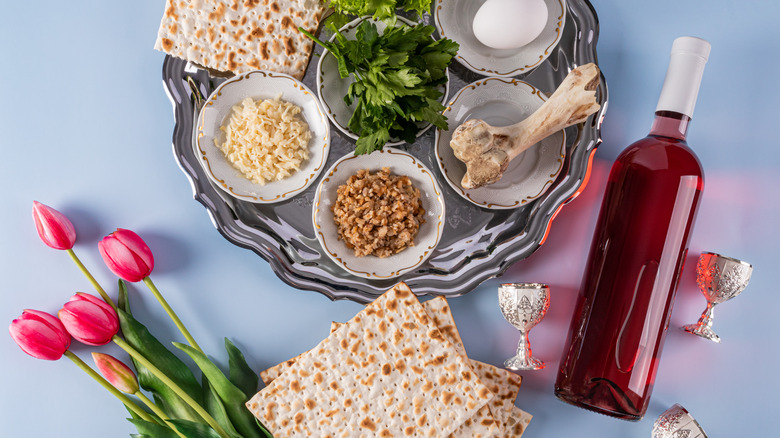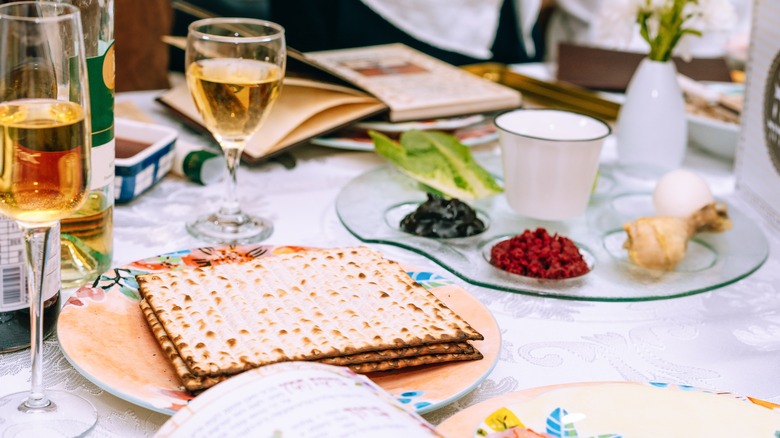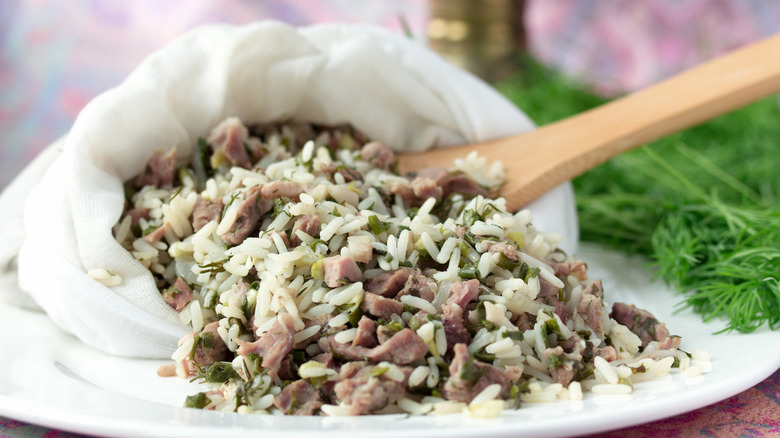Here's Why Some People Don't Eat Rice During Passover
In Judaism, Passover commemorates the liberation of the Jewish people from enslavement in Egypt, as described in the book of Exodus. As told, the Jews had to leave quickly without even time to let the bread rise, which they took with them as sustenance. Thus, during the week-long observance of Passover (Pesach in Hebrew), only unleavened bread in the form of cracker-like matzah is allowed. All other foods made with the five main grains — wheat, barley, rye, oats, or spelt, which have been fermented and risen, are considered chametz (leavened) — and are forbidden.
There are four major Jewish ethnic groups: Ashkenazi, Sephardic, Mizrahi, and Ethiopian. Along with the avoidance of leavened bread and foods, the Ashkenazim (those who had to relocate to Central Europe) practice another food prohibition; they do not eat kitniyot foods (other foods not safe for Passover) — this includes rice, legumes like beans, lentils, millet, and in some communities, corn, other grasses, and seeds.
One of the main reasons rice and other kitniyot foods are not eaten during Passover stems from a 13th-century Talmudic teaching that warned that unleavened grains could accidentally be stored together with or confused for rice or beans, leading to chametz foods being mistakenly consumed. Although modern food production practices and packaging have largely done away with concerns over the mixing up of foods that might be consumed unintentionally, the tradition has continued to be observed by Ashkenazi Jews. Recent changes to kosher food laws, however, have begun altering some of these traditions.
The rule change that made rice kosher for Passover
In 2015, the Rabbinical Assembly declared an overhaul to the rules that deem what is kosher for Passover. Their issuance of the document "A Teshuvah Permitting Ashkenazim to Eat Kitniyot on Pesah" overturned how Passover has been celebrated for over 800 years by allowing kitniyot. This means that rice and other forbidden foods are back on the menu to be enjoyed alongside traditional recipes like low and slow wine-braised brisket and even some not-so-traditional ones like Mexican Passover matzo balls with mushrooms and jalapeños.
There are a few reasons for this significant change. Along with the fact that most people today aren't likely to mistake white flour for a bag of rice, another reason is a remarkable nod towards vegetarians and vegans. The rabbis acknowledged that the world "is moving, for health reasons, away from large scale consumption of meat and a greater focus on the nutrition of vegetables and beans." The justification is that for those who do not eat meat, fish, dairy, or eggs, beans are an important protein source to include at the seder table.
They also cite the prohibitive cost of purchasing products sanctioned as kosher for Passover, and that by allowing foods that can be cooked at home, the observance of the holiday is made less expensive and exclusionary. Despite the new expansive rules, some Ashkenazim still choose to abstain from eating rice at Passover, following their family's customs passed down through the generations.
Other kitniyot rice customs during Pesach
Outside of Ashkenazi traditions, the rules regarding which foods are allowed during Passover give more leeway but can be equally complex due to the many different Jewish lineages and cultural differences among them. Sephardic Jewry trace their ancestry back to 15th century Spain while the Mizrahi are indigenous to the Middle East and North Africa. While most Sephardic and Mizrahi dietary laws have always permitted certain kitniyot foods for Pesach, with rice often prominently featured in seder feasts, such foods are not considered acceptable across the board.
Moroccan Jews, for example, allow legumes but forbid rice. Bukharan Jews of Central Asia (modern Uzbekistan and Tajikistan) consume rice but not cabbage, corn, or peas. Similarly, Jews from India (known as the Bene Israel) will eat rice but not beans or peas. One of their specialties is a griddle-cooked flatbread made from rice.
Some traditions involve purchasing large quantities of rice in advance of Passover with families gathering to sift carefully through the grains to make sure there are no other chametz ingredients found in the mix. Once deemed kosher, it can then be used to make delicious grape leaves stuffed with rice. In the Middle East, rice is used to make Syrian or Lebanese kibbeh, a fried snack similar to falafel usually made with bulgur wheat and spiced meat. Another Mizrahi recipe from Iraq is t'bit (sometimes spelled tbeet), which is a slow-cooked aromatic dish of chicken stuffed with rice and spiced with baharat.



